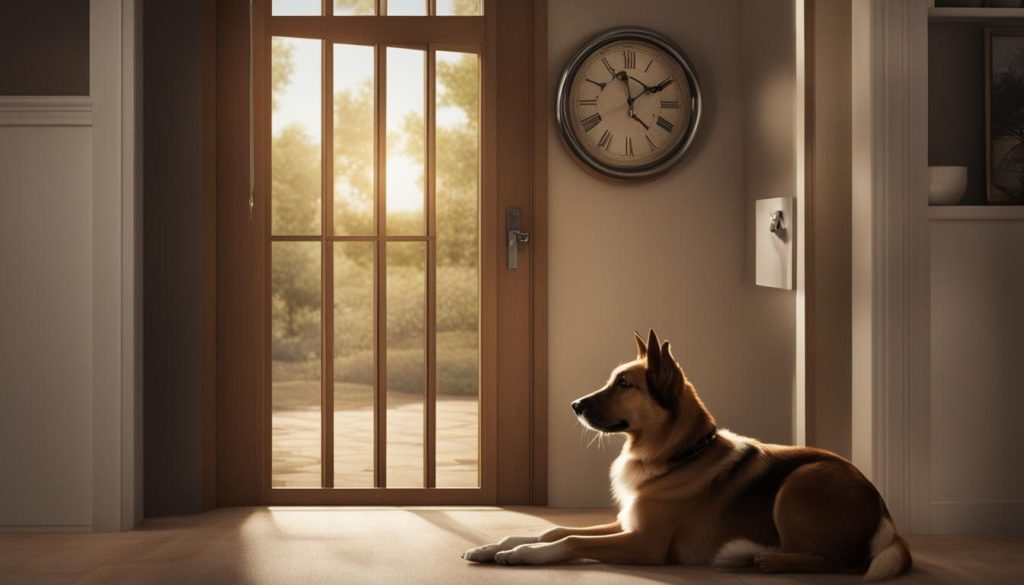As dog owners, we often wonder how our furry companions perceive time. Do they experience time the same way we do? The truth is, dogs have a unique understanding of time, influenced by their psychology and sensory perception. In this article, we will delve into the concept of dog time and explore how dogs perceive the passage of time.
Dogs’ perception of time differs from humans due to various factors, such as breed, size, and activity level. Understanding their time perception is not only fascinating but also essential for providing the best care for our canine friends. By measuring time in dog minutes and converting it to human time, we can bridge the gap between their perception and ours.
Key Takeaways:
- Dogs perceive time differently than humans, influenced by their psychology and sensory experience.
- Converting human time to dog time can be done using a ratio of 1:7, where one minute in human time is approximately equal to seven minutes in dog time.
- Factors like breed, size, and activity level can also affect a dog’s perception of time.
- Understanding dog time and their unique psychology can strengthen the bond between dog owners and their pets.
- Consideration of dog time can lead to improved care and a deeper understanding of our furry companions.
How Dogs Perceive Time

Dogs have a unique way of perceiving time, which differs from our human perception. While we measure time using clocks and calendars, dogs rely on their senses and memory to understand the passing of time. Their sensory perception and memory capacity play key roles in how they perceive time.
A dog’s sense of time is closely tied to their sensory experiences. Dogs have a highly developed sense of smell, which allows them to gather information about their environment and detect subtle changes. They can sense the passage of time through the familiar smells and scents associated with different times of day or specific activities.
“Dogs have an amazing ability to remember events and routines, which contributes to their perception of time.”
Additionally, a dog’s memory capacity influences their perception of time. Dogs have an amazing ability to remember events and routines, which contributes to their perception of time. They can anticipate certain activities or events based on their memory, and this influences how they perceive the passage of time.
Overall, understanding how dogs perceive time can help us better comprehend their behavior and needs. While they may not understand time in the same way we do, their sensory perception and memory allow them to create their own unique perception of the passing moments.
Dog Time Conversion

When it comes to understanding our furry friends, one aspect that often puzzles dog owners is how dogs perceive time. While humans rely on clocks and calendars to track time, dogs have a different perception. To bridge this gap and better relate to our canine companions, it can be helpful to convert human time to dog time.
The general consensus is that one minute in human time is approximately equal to seven minutes in dog time. This conversion ratio, 1:7, provides a rough estimate of how dogs experience the passing of time. So, if you’re wondering how long a few minutes would feel like for your dog, it would be equivalent to about 20 minutes in human time.
This conversion can serve as a useful tool for dog owners to better understand their pets’ time perception. It can help manage expectations and provide insights into why dogs may seem impatient or eager during certain activities. For example, leaving a dog alone for an hour in human time can feel like a significant period of separation anxiety for them, as it translates to almost seven hours in dog time.
Understanding the concept of dog time conversion can deepen the bond between humans and their canine companions. It allows us to consider their unique perception of time and adjust our interactions and routines accordingly, leading to improved overall well-being for our furry friends.
Table: Dog Time Conversion
| Human Time | Dog Time |
|---|---|
| 1 minute | 7 minutes |
| 5 minutes | 35 minutes |
| 30 minutes | 3.5 hours |
| 1 hour | 7 hours |
Please be aware that this conversion ratio is an approximation and may vary slightly between individual dogs. Factors such as breed, size, and activity level can also influence a dog’s perception of time. Smaller breeds with longer lifespans, for example, may have a slightly different time perception compared to larger breeds.
Ultimately, dog time conversion provides a starting point for understanding our dogs’ unique experience of time. By considering their perspective, we can enhance our interactions and strengthen the bond between humans and dogs.
Factors Affecting Time Perception in Dogs

Time perception in dogs can be influenced by several factors, including breed, size, and activity level. These factors play a significant role in how dogs experience and perceive the passing of time. Understanding these factors can provide valuable insights into our furry companions’ unique time perception and help us better cater to their needs.
1. Breed and Time Perception
Different dog breeds may have variations in their time perception due to variations in lifespan and aging processes. Smaller dog breeds tend to have longer lifespans compared to larger breeds, which can affect how they perceive time. Additionally, certain breeds may exhibit heightened or reduced activity levels, which can further impact their time perception.
2. Size and Time Perception
The size of a dog can also affect its perception of time. Smaller dogs generally have slower metabolic rates and longer lifespans, which may result in a different experience of time compared to larger dogs. It’s important to consider the size of a dog when trying to understand its time perception and adjust our expectations accordingly.
3. Activity Level and Time Perception in Dogs
The activity level of a dog can influence its perception of time. Dogs with high activity levels may have a heightened sense of time due to their active lifestyle and constant engagement with their surroundings. On the other hand, dogs with lower activity levels may have a more relaxed perception of time, as they spend less time engaged in physical or mental activities.
By taking into account these factors, we can gain a deeper understanding of how dogs perceive time and tailor our interactions and care to meet their needs. It’s important to remember that each dog is unique, and factors such as breed, size, and activity level should be considered in combination with individual characteristics and personality traits.
| Factors | Effect on Time Perception |
|---|---|
| Breed | Variations in lifespan and aging processes can influence how dogs perceive time. |
| Size | Smaller dogs generally have slower metabolic rates and longer lifespans, which may impact their time perception. |
| Activity Level | Dogs with higher activity levels may have a heightened sense of time, while those with lower activity levels may have a more relaxed perception. |
Understanding the factors that affect time perception in dogs allows us to develop a deeper appreciation for their unique experiences and needs. By considering a dog’s breed, size, and activity level, we can provide them with the appropriate care and engage in meaningful interactions, enhancing their overall well-being.
Understanding Dog Years

As dog owners, it’s important to understand the concept of “dog years” and how they relate to the aging process of our furry companions. While the general approximation of one dog year equaling seven human years is often used, the reality is more nuanced. Dogs have a different aging process, and their lifespan is shorter compared to humans. This means that they experience the passage of time differently.
Table: Comparison of Dog Years and Human Years
| Dog Age | Small Breed | Medium Breed | Large Breed |
|---|---|---|---|
| 1 year | 15 years | 15 years | 15 years |
| 2 years | 24 years | 24 years | 24 years |
| 3 years | 28 years | 28 years | 28 years |
This table illustrates the approximate equivalent of dog years to human years for different ages and sizes. It’s worth noting that the aging process may vary based on factors such as breed, size, and overall health.
Understanding dog years is not only important for estimating a dog’s age in human terms but also for providing appropriate care as they age. Dogs may experience physical and cognitive changes as they grow older, and being aware of their unique aging process can help us identify and address their specific needs. By considering the concept of dog years, we can ensure that our beloved pets receive the best possible care throughout their lives.
Sensory Perception in Dogs

When it comes to perceiving the world around them, dogs rely heavily on their senses. Their heightened sense of smell and different visual abilities compared to humans contribute to their unique perception of time. Dogs have an olfactory system that is far more developed than ours, allowing them to detect a wide range of scents and track smells over time. This keen sense of smell not only helps them navigate their environment but also provides them with important information about the passage of time.
In addition to their sense of smell, dogs also have visual abilities that differ from humans. While human vision is optimized for seeing fine details and a wide range of colors, dogs have a more limited color vision and a higher sensitivity to motion. This means that they may perceive visual stimuli differently and may have a different sense of the passing of time based on visual cues.
Overall, the combination of their exceptional sense of smell and unique visual abilities allows dogs to have a sensory perception that is distinct from humans. This sensory perception influences how they experience and understand the concept of time, leading to their own sense of time perception.
By understanding the sensory perception of dogs, we can gain insights into their perception of time. This knowledge can help us better understand and care for our furry companions, as we can take their sensory experiences into account when considering their time perception. Whether it’s taking them for a walk to allow them to explore scents or providing them with visually stimulating environments, catering to their sensory needs can enhance their overall well-being and happiness.
The Importance of Enrichment Activities
Enrichment activities play a crucial role in keeping dogs mentally and physically stimulated. For dogs, time perception is not just about the passage of minutes and hours but also about the quality of their experiences. Providing them with opportunities to engage their senses through activities such as scent games, puzzle toys, and interactive play can help enrich their lives and make their concept of time more fulfilling.
Cognitive Perception in Dogs
In understanding how dogs perceive time, it is essential to consider their cognitive abilities and memory. Dogs, like humans, have the capacity to form memories and associate events with certain cues, but their memory is not as detailed or long-lasting as ours. This plays a significant role in their perception of time.
Dogs rely on their cognitive abilities to navigate their daily routines and understand basic concepts such as cause and effect. They can remember specific routines, such as mealtime or daily walks, which helps them establish a sense of structure in their lives. However, their memory is more influenced by their immediate surroundings and experiences, rather than abstract concepts like hours or days.
Additionally, dogs’ cognitive perception of time is influenced by their ability to live in the present moment. Unlike humans, who often dwell on past events or anticipate future ones, dogs live in the here and now. This focus on the present can make time feel more fluid for them, as they are fully engaged with their immediate environment and experiences.
The Role of Memory in Dogs’ Time Perception
Memory plays a vital role in how dogs perceive time. It enables them to remember past experiences, associate them with specific cues, and make predictions about future events. While their memory is not as extensive as ours, it is still a powerful tool for understanding time in their own canine way.
Dogs’ memory of past events helps them establish routines and recognize patterns, allowing them to anticipate certain activities or events. For example, they may start getting excited or anxious when they see their owner grabbing the leash, knowing that a walk is about to happen. These associations contribute to their perception of time and help them navigate their daily lives.
However, it is important to note that dogs’ memory is not infallible, and they rely more on their senses and immediate experiences. They may not remember every detail or occurrence, and their memory can be influenced by their emotional states and external factors. Nonetheless, their cognitive abilities and memory play an integral role in their perception of time.
| Factors Affecting Dogs’ Cognitive Perception of Time | Description |
|---|---|
| Breed | Different dog breeds may have variations in cognitive abilities, memory, and overall perception of time. Some breeds are known for their sharp intellect, while others may have a more instinctual approach to the world. |
| Individual Differences | Just like humans, dogs have individual differences in their cognitive abilities and memory. Some dogs may have better memory retention or problem-solving skills than others, which can affect their perception of time. |
| Training | Training can shape dogs’ cognitive perception of time. Dogs that have undergone training may have a better understanding of certain cues and routines, which can influence their perception of time and their ability to anticipate events. |
In conclusion, dogs perceive time cognitively, relying on their cognitive abilities and memory to navigate their daily routines. While their memory is not as extensive as humans’, it still plays a significant role in their perception of time. Understanding their unique cognitive perception can help us better meet their needs and provide them with the care they deserve.
Dog Time vs Human Time
Understanding the difference between dog time and human time is crucial for dog owners who want to better relate to their pets. Dogs perceive time differently than humans due to variations in their perception and aging processes. Converting dog time to human time can be done using conversion charts or ratios. Let’s explore the fascinating world of dog time and how it compares to our own.
Conversion Chart: Dog Time to Human Time
| Dog Time (Minutes) | Human Time (Minutes) |
|---|---|
| 1 | 7 |
| 5 | 35 |
| 10 | 70 |
| 15 | 105 |
The table above demonstrates the conversion from dog time to human time using a ratio of 1:7. For example, one minute in human time is approximately equal to seven minutes in dog time. This conversion chart can help dog owners better understand their pet’s perception of time.
“Understanding the difference between dog time and human time can lead to a better understanding of our furry companions and improve their overall well-being.” – Dog Time Magazine
While the conversion chart provides a general guideline, it’s important to remember that different factors can influence a dog’s perception of time, such as breed, size, and activity level. Smaller dogs tend to have longer lifespans, which may affect their time perception compared to larger dogs. Additionally, different breeds may age at different rates, impacting their time perception as well.
By considering dog time and taking into account their unique psychology, dog owners can establish a stronger bond with their pets and provide them with the care they need. Understanding dog time vs human time is a valuable insight into the world of our canine companions.
Impact of Size and Breed on Time Perception
Size and breed play significant roles in a dog’s perception of time. Smaller dogs and larger dogs have different lifespans, which can affect how they experience the passing of time. Generally, smaller dog breeds tend to live longer compared to larger breeds. For example, small breeds like Chihuahuas or Dachshunds have an average lifespan of 12-16 years, while larger breeds like Great Danes or Saint Bernards have an average lifespan of 8-10 years.
This difference in lifespan can impact a dog’s perception of time. Smaller dogs have more years to experience and perceive, potentially making each year feel shorter compared to larger dogs. In contrast, larger dogs may feel that time passes more quickly, as their lifespan is relatively shorter.
| Breed Size | Average Lifespan (years) |
|---|---|
| Small | 12-16 |
| Medium | 10-12 |
| Large | 8-10 |
Please be aware that breed plays a role in time perception as well. Each breed has its own unique characteristics and traits, which can influence how they perceive the passage of time. For example, highly active breeds like Border Collies or Australian Shepherds may have a heightened sense of time due to their active lifestyles and higher energy levels. On the other hand, calmer breeds like Bulldogs or Basset Hounds may have a more relaxed perception of time.
Understanding the impact of size and breed on a dog’s time perception can help owners better relate to their pets and provide appropriate care. By considering these factors, we can create a deeper connection with our furry companions and ensure their well-being.
Dog Time and Aging
Understanding how dogs age and the impact of time on their physical and cognitive abilities is crucial for providing them with appropriate care. Dogs go through a natural aging process, and their lifespan is relatively shorter compared to humans. By considering the factors that influence their aging and time perception, we can better address their needs and ensure their well-being.
The aging process in dogs varies depending on factors such as breed, size, and overall health. Larger breeds tend to have shorter lifespans compared to smaller breeds. For example, small dog breeds like Chihuahuas can live up to 15 years or more, while large breeds like Great Danes may have an average lifespan of about 7 to 10 years. Understanding the typical lifespan of different breeds helps us gauge their aging process and adjust our care accordingly.
As dogs age, they may experience physical and cognitive changes. These changes can include reduced mobility, joint stiffness, and cognitive decline. It’s important to provide older dogs with proper nutrition, regular exercise, and regular veterinary check-ups to manage any age-related health issues. Adaptations to their environment, such as providing ramps or orthopedic bedding, can also improve their comfort and quality of life.
| Age | Physical Changes | Cognitive Changes |
|---|---|---|
| Senior (7-10 years) | Reduced activity level, weight gain, gray hair | Mild memory decline, decreased problem-solving abilities |
| Geriatric (10+ years) | Further decline in mobility, decreased senses | More noticeable memory decline, disorientation |
As responsible dog owners, it is our duty to provide our furry companions with the care they need as they age. By understanding the impact of time on their physical and cognitive abilities, we can ensure their comfort, health, and happiness throughout their lives.
The Effect of Time on Dogs’ Emotional Well-being

Time plays a crucial role in dogs’ emotional well-being, as their perception of time can significantly impact their emotions. Dogs form strong attachments to their owners and thrive on consistent routines and companionship. When separated from their owners for extended periods, dogs may experience anxiety and distress.
Dogs’ perception of time differs from humans, and they may have difficulty understanding why their owners are absent for long periods. This can lead to separation anxiety, manifested through behaviors like excessive barking, destructive chewing, or even self-harm. It is important for dog owners to be aware of their pets’ time perception and take steps to alleviate their anxiety.
Creating predictable routines and providing mental stimulation can help dogs cope with the passage of time. Engaging in regular exercise and playtime can help alleviate anxiety and provide a positive outlet for their energy. Additionally, establishing a safe and comfortable space for dogs when they are left alone can help them feel secure and reduce their anxiety levels.
The Importance of Bonding Time
Spending quality time with your dog is essential for their emotional well-being. Engaging in activities that strengthen the bond between you and your pet, such as training sessions, interactive play, or simply cuddling, can help alleviate any distress caused by time apart. This dedicated bonding time helps dogs feel loved, secure, and reassured that they are an important part of your life.
“Dogs are not our whole life, but they make our lives whole.” – Roger Caras
Understanding the impact of time on dogs’ emotional well-being allows us to provide the care and support they need to thrive. By recognizing their unique perception of time and taking steps to alleviate anxiety, we can ensure that our furry companions lead happy, fulfilling lives.
Wrapping Up
Understanding dog time perception is crucial for dog owners to provide optimal care and nurture a strong bond with their furry companions. Dogs perceive time differently than humans, relying on their sensory experience, memory, and cognitive abilities.
Factors such as breed, size, and activity level can influence a dog’s perception of time. By converting human time to dog time using a ratio of 1:7, owners can better relate to their dog’s time perception and adjust their routines accordingly.
Furthermore, dogs age at a faster rate than humans, and their unique aging process affects their time perception. Recognizing these differences and understanding the impact of time on dogs’ emotional well-being can help alleviate anxiety and provide the care they need.
To truly understand our canine companions, we must appreciate their distinct psychology and time perception. By considering dog time, we enhance our ability to meet their needs, strengthen our connection, and provide them with a fulfilled and enriched life.
FAQ
How long is a few minutes in dog time?
Dogs perceive time differently than humans, but a general conversion ratio is 1 minute in human time equals approximately 7 minutes in dog time.
How do dogs perceive time?
Dogs perceive time based on their sensory experience and memory. Their memory capacity and sensory perception influence how they perceive the passing of time.
How can I convert human time to dog time?
You can use a ratio of 1 minute in human time equals approximately 7 minutes in dog time to convert human time to dog time.
What factors affect a dog’s perception of time?
Several factors can influence a dog’s perception of time, including breed, size, and activity level. Different breeds may have different time perception due to variations in lifespan and aging processes.
How can I understand dog years in relation to human years?
While the concept of one dog year equaling seven human years is a general approximation, the aging process in dogs is not linear. Understanding the difference between dog years and human years is crucial for estimating a dog’s age in human terms.
How do dogs experience the world through their senses?
Dogs experience the world through their senses, including their heightened sense of smell and different visual abilities compared to humans. These sensory differences contribute to their unique perception of time.
How does a dog’s memory capacity affect their perception of time?
Dogs can remember events and certain routines, but their memory is not as detailed as humans’. This can affect their perception of time, as their memory plays a role in their understanding of time.
What is the difference between dog time and human time?
Dog time is different from human time due to variations in perception and aging processes. Converting human time to dog time can be done using conversion charts or the ratio of 1:7.
How does size and breed affect a dog’s perception of time?
Smaller dogs tend to have longer lifespans and may experience time differently compared to larger dogs. Different dog breeds may have variations in aging processes, which can affect their perception of time.
How does time impact a dog’s aging process?
Dogs age at a different rate than humans, and their perception of time is linked to the aging process. Understanding how dogs age and the impact of time on their physical and cognitive abilities is essential for providing appropriate care.
How does time affect a dog’s emotional well-being?
Dogs’ perception of time can influence their emotions, and they may feel anxious or distressed when separated from their owners for extended periods. Understanding their unique time perception can help alleviate anxiety and provide better care.
What is the conclusion about dog time perception?
Understanding dogs’ perception of time, including the concept of dog years and their unique psychology, can strengthen the bond between dog owners and their pets and improve their overall well-being.






